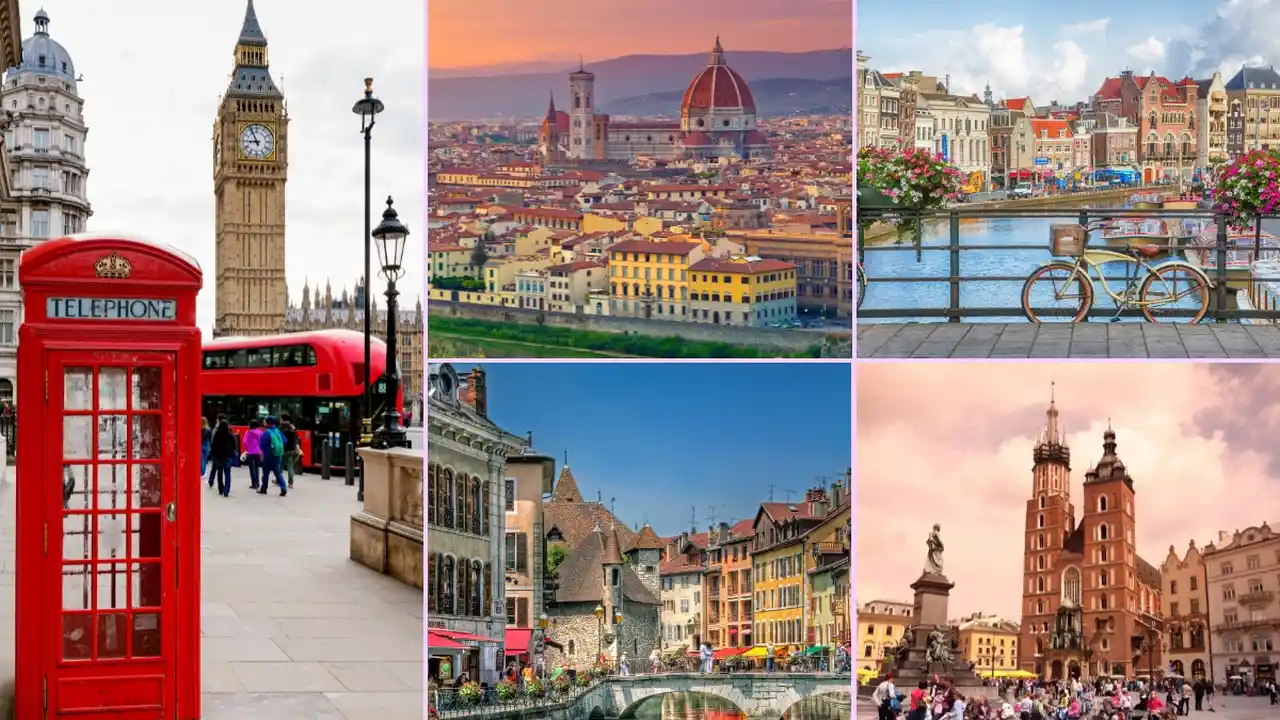Best Time to Visit Europe: A Seasonal Guide for Americans
Sample meta description.

Planning Your European Vacation Unveiling the Best Time to Travel
So, you're dreaming of Europe? Awesome! Castles, cobblestone streets, amazing food... it's all waiting for you. But before you pack your bags, the BIG question: when should you actually GO? Europe isn't a one-size-fits-all destination. The best time to visit depends on what you want to see, what you want to do, and how much you're willing to spend (and put up with in terms of crowds!). This guide breaks down the seasons, so you can pinpoint the perfect time for your European adventure.
Spring in Europe: European Spring Travel Guide for American Tourists
Spring (April-May) is a fantastic time to go. The weather is generally mild, the flowers are blooming (think tulips in the Netherlands!), and the crowds haven't reached peak summer madness. Plus, prices are often lower than in June, July, and August. Think about Easter celebrations – they’re a big deal in many European countries and can be a lot of fun to experience. Just be prepared for some rain showers; pack a light jacket and an umbrella.
What to pack for Spring: Layers are your best friend! A light jacket, a sweater, comfortable walking shoes, an umbrella, and sunglasses are essential.
Where to go in Spring:
- Netherlands: Tulip season is a must-see!
- Italy: Explore Rome, Florence, and Venice before the summer heat sets in.
- Spain: Enjoy the festivals and vibrant culture of Seville and Barcelona.
- Paris: Experience the romance of Paris in bloom.
Summer in Europe: Summer Travel Tips for American Travelers in Europe
Summer (June-August) is peak season for a reason. The weather is warm and sunny almost everywhere, and there are tons of festivals and events going on. However, be prepared for large crowds, higher prices, and potentially scorching temperatures, especially in Southern Europe. Book accommodations and tours well in advance!
What to pack for Summer: Light and breathable clothing, sunscreen, a hat, sunglasses, comfortable walking shoes, and swimwear if you plan on hitting the beach.
Where to go in Summer:
- Greek Islands: Island hopping is a classic summer activity.
- French Riviera: Enjoy the beaches and glamour of Nice and Cannes.
- Scandinavia: Explore the fjords and enjoy the long summer days.
- London: Take advantage of the outdoor events and parks.
Autumn in Europe: European Fall Foliage and Autumn Vacations for Americans
Autumn (September-October) is another great shoulder season. The crowds start to thin out, the weather is still pleasant in many areas, and the fall foliage is stunning. Plus, you can often find good deals on flights and accommodations. Consider visiting vineyards during harvest season – many offer tours and tastings.
What to pack for Autumn: Layers are still important! A light jacket, a sweater, comfortable walking shoes, and a scarf are essential. You might also want to pack a waterproof jacket, as rain is more likely than in summer.
Where to go in Autumn:
- Germany: Experience Oktoberfest in Munich.
- Italy: Explore Tuscany during the grape harvest.
- Scotland: Enjoy the stunning fall foliage in the Highlands.
- Prague: Wander through the charming streets of Prague in the crisp autumn air.
Winter in Europe: European Christmas Markets and Winter Activities for American Tourists
Winter (November-March) is a magical time to visit Europe, especially if you're interested in Christmas markets and winter sports. However, be prepared for cold weather, shorter days, and potentially snow. Some attractions may have limited hours or be closed altogether. But the festive atmosphere and cozy charm of European cities in winter can be truly unforgettable.
What to pack for Winter: Warm clothing is essential! A heavy coat, gloves, a hat, a scarf, waterproof boots, and warm socks are a must.
Where to go in Winter:
- Germany: Explore the traditional Christmas markets.
- Austria: Go skiing in the Alps.
- Iceland: See the Northern Lights.
- Paris: Experience the magic of Paris during the holiday season.
Travel Gear Recommendations Essential Travel Products for Europe
Alright, let's talk gear. Having the right stuff can make or break your trip. Here are a few recommendations based on different scenarios:
Luggage Options Suitcases and Backpacks for European Travel
Scenario: You're planning a multi-city trip by train and don't want to lug a heavy suitcase around.
Recommendation: The Osprey Farpoint 40 Travel Backpack. This backpack is carry-on sized, comfortable to wear, and has a clamshell opening for easy packing. It's also durable and has plenty of pockets for organization.
Comparison: Compared to a traditional suitcase, the Osprey Farpoint 40 is much easier to maneuver on trains and cobblestone streets. Compared to other travel backpacks, the Osprey Farpoint 40 is known for its comfort and durability.
Price: Around $160 - $180.
Scenario: You're planning a shorter trip and prefer a rolling suitcase.
Recommendation: The Away Carry-On. This suitcase is stylish, durable, and has a built-in USB charger.
Comparison: Compared to cheaper suitcases, the Away Carry-On is made with higher-quality materials and has better wheels. Compared to more expensive suitcases, the Away Carry-On offers excellent value for the price.
Price: Around $275.
Travel Adapters Staying Connected Power Adapters for American Tourists in Europe
Scenario: You need to charge your phone, laptop, and other electronics.
Recommendation: The EPICKA Universal Travel Adapter. This adapter works in most countries, including all of Europe. It has multiple USB ports and a surge protector.
Comparison: Compared to cheaper adapters, the EPICKA adapter is more durable and has better safety features. Compared to other universal adapters, the EPICKA adapter is known for its reliability and ease of use.
Price: Around $25.
Comfortable Walking Shoes Exploring Europe on Foot
Scenario: You'll be doing a lot of walking.
Recommendation: The Allbirds Wool Runners. These shoes are comfortable, lightweight, and breathable. They're also machine washable.
Comparison: Compared to other sneakers, the Allbirds Wool Runners are more sustainable and comfortable. Compared to hiking shoes, the Allbirds Wool Runners are more stylish and versatile.
Price: Around $100.
Noise Cancelling Headphones Staying Relaxed on Flights and Trains
Scenario: You want to block out noise on flights, trains, and in crowded areas.
Recommendation: The Sony WH-1000XM5 Noise Cancelling Headphones. These headphones offer excellent noise cancellation, great sound quality, and are comfortable to wear for long periods.
Comparison: Compared to other noise-cancelling headphones, the Sony WH-1000XM5 offer superior noise cancellation performance and a more comfortable fit. While Bose are a strong competitor, the Sony's often edge out in terms of overall sound profile and features.
Price: Around $400.
Portable Power Bank Staying Charged on the Go
Scenario: You need to charge your phone on the go.
Recommendation: The Anker PowerCore 10000 Portable Charger. This power bank is small, lightweight, and can charge your phone multiple times.
Comparison: Compared to other power banks, the Anker PowerCore 10000 is known for its reliability and fast charging speeds. It's also a very affordable option.
Price: Around $25.
Budgeting Your Trip Cost Saving Tips for European Vacations
Europe can be expensive, but it doesn't have to break the bank. Here are some tips for saving money:
- Travel during the shoulder seasons: Spring and autumn offer lower prices and fewer crowds.
- Book flights and accommodations in advance: This can save you a significant amount of money.
- Consider staying in hostels or Airbnb apartments: These are often cheaper than hotels.
- Eat like a local: Avoid tourist traps and try local restaurants and street food.
- Take advantage of free activities: Many cities offer free walking tours, museums, and parks.
- Use public transportation: It's often cheaper and more convenient than taxis.
- Look for city passes: These can offer discounts on attractions and transportation.
Visa and Passport Requirements Ensuring a Smooth Entry to Europe
Make sure your passport is valid for at least six months beyond your planned return date. Americans can usually stay in the Schengen Area (most of Western Europe) for up to 90 days without a visa. However, check the specific requirements for the countries you plan to visit.
Staying Safe and Healthy Tips for a Worry-Free European Adventure
Be aware of your surroundings and take precautions against pickpockets, especially in crowded areas. Drink bottled water, and make sure you have travel insurance that covers medical expenses.
Embrace the European Culture Immersing Yourself in Local Traditions
Learn a few basic phrases in the local language. Be respectful of local customs and traditions. Try new foods and experiences. Most importantly, have fun!
:max_bytes(150000):strip_icc()/277019-baked-pork-chops-with-cream-of-mushroom-soup-DDMFS-beauty-4x3-BG-7505-5762b731cf30447d9cbbbbbf387beafa.jpg)






